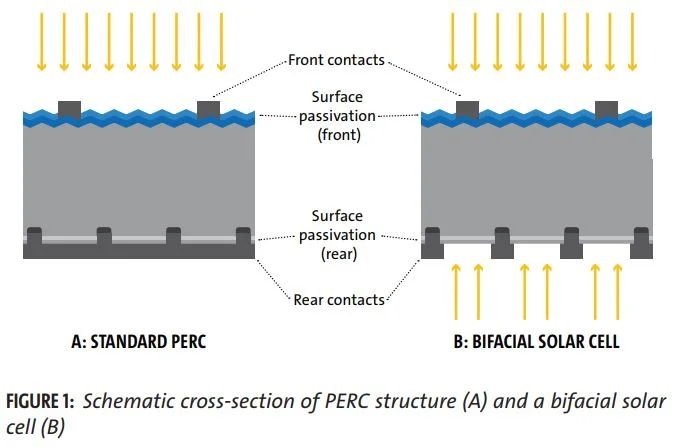I hope you enjoyed last week's episode with Suvi Sharma of Solaria where we discussed their newest innovation of Architectural PV Glass!
On today's episode, I got to speak with Hongbin Fang.
Hongbin is the Director of Product Marketing at LONGi Solar, a leading dedicated monocrystalline solar cell and module manufacturer.
With the resurgence of Bifacial Modules & the rapid rise of the PERC cell technology, I thought it would be good to bring in an expert on the subject to help us understand the technical bits and why it matters to the industry.
Tune in Today as we Discuss:
The rise of PERC Mono solar cell technology - what is it, and why should we care?
The re-emergence of bifacial modules - what's new, and how does it help developers deliver more kWh?
For those of you that like to read and research even more, the following are the sites and insights I collected preparing for this episode. Enjoy.
Let’s first have a look at PERC (Passivated Emitter Rear Cell) Technology & trends:
In case you're the visual type - here's a decent snippet from SolarWorld's white paper showing the basic difference between normal PERC and bifacial cells.
As far back as 2014 GTM was touting the PERC tech as "gaining ground…but price premiums [still] steep."
And in 2015, Sinovoltaics touted that PERC will become the dominant technology!
This article is perfectly geeky and even goes into how PERC cells catch different types of wavelengths. If you really want down the rabbit hole, look no further.
In particular, I learned:
There are three main reasons why the dielectric passivation layer contributes to the increase of efficiency:
The extra dielectric passivation layer reduces electron recombination: Electron recombination is the tendency of electrons to recombine and basically block the electrons from freely flowing through the solar cell, which means it can’t reach its potential efficiency.Electrons generated near the back of the solar cell are now free to move up to the emitter and contribute to more electrical current.
The dielectric layer reflects the light that passes through the solar cell without generating any electrons. By reflecting this light, the photons are given more opportunity to generate electrical current.
The extra dielectric passivation layer increases the solar cell’s ability to capture light: Silicon wafers stop absorbing wavelengths above 1180 nm. In normal solar cells, such wavelengths are easily absorbed by the backside metallization and turned into heat. The extra dielectric passivation layer reflects wavelengths above 1180 nm out of the solar cell, that would normally create heat.
As you know, heat reduces the solar cell’s conversion efficiency. The dielectric passivation layer reflects wavelengths above 1180 nm out of the solar cell, and helps the solar cell to work more efficiently by maintaining cooler temperatures.
And, that last point was altogether new information to me!
Next we can look at Bifacial Module trends, science and adoption
This project in China claims to be the largest deployment of Bifacial, at 71MW
SolarWorld actually created something more-or-less worthwhile, this whitepaper on maximizing energy yield from bifacial modules. I particularly liked the easy-to-understand comparison of standard PERC & Bifacial Solar Cells (that first image I used above).
Trina Solar solar is well-known for their extensive testing & thought leadership supporting innovation in solar modules. Here, we have a takeaway from their real-world tests at their factory testing field that include normal installs as well as bifacial modules "on tracker"
The tests measured the bifacial module power output and energy gain with and without a mechanical tracker on three different fields: grass, sand and a white-painted surface.
Using monofacial modules as a baseline the test found that:
On grass: 5.2 percent energy gain.
On grass with a tracker: 10.57 percent energy gain.
On sand: 10.79 percent energy gain.
On sand with a tracker: 24.42 percent energy gain.
On white-painted surface: 21.9 percent energy gain.
On white-painted surface with a tracker: 33.2 percent energy gain.
As the results show, bifacial modules outperform standard panels in every category, while trackers add even greater energy gains. Further, when combined with a tracker and placed on a white-painted surface, bifacial modules outperform the standard monofacial panels by more than a third!!!
Here's to hoping that's data you can take to the bank!
Links & Resources:
Follow Hongbin on LinkedIn
You can also find the US GM, Archie Flores on LinkedIn
And, of course, learn more on their website - LONGi Solar
About the Host of SunCast:
Nico Johnson is the creator and host of SunCast, a regular conversation with Solar Industry professionals who are leading in emerging solar markets. The content of the show is geared towards listeners looking for insights on where the markets are headed, how to position themselves or their companies, and what today's market leaders do to stay ahead of the pack.
Nico is a 10-year veteran of the solar industry, having led development in the US and Latin America for global companies like Trina Solar and Conergy. He served as a Peace Corps volunteer in Guatemala and is considered one of the market's leading experts on solar PV expansion in the region.
Nico can be reached on Linked In https://www.linkedin.com/in/nickalus
or by email nico@mysuncast.com
Thanks again for setting aside THIS time in your day. Enjoy this week’s episode of SunCast, with Hongbin Fang.




